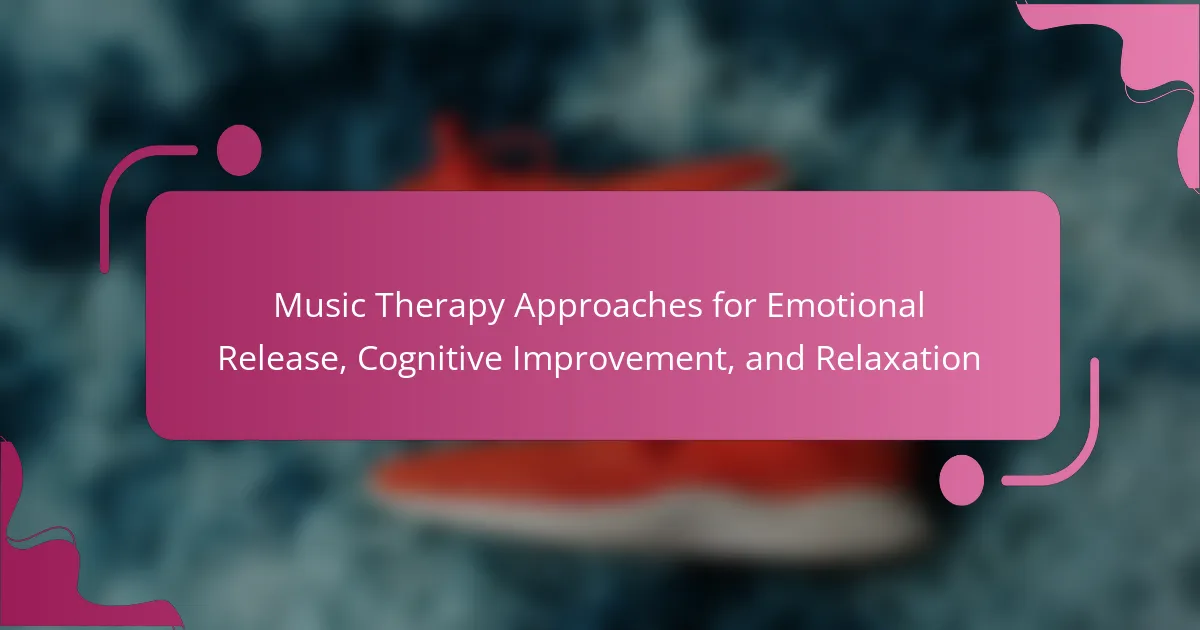Music therapy offers significant benefits for emotional release, cognitive improvement, and relaxation. It helps individuals express complex emotions, enhances cognitive functions like memory and attention, and promotes stress relief through various techniques. This article explores the approaches used in music therapy, the challenges therapists face, and the regional variations that influence its practice. Understanding these aspects can enhance the effectiveness of music therapy in supporting mental well-being.
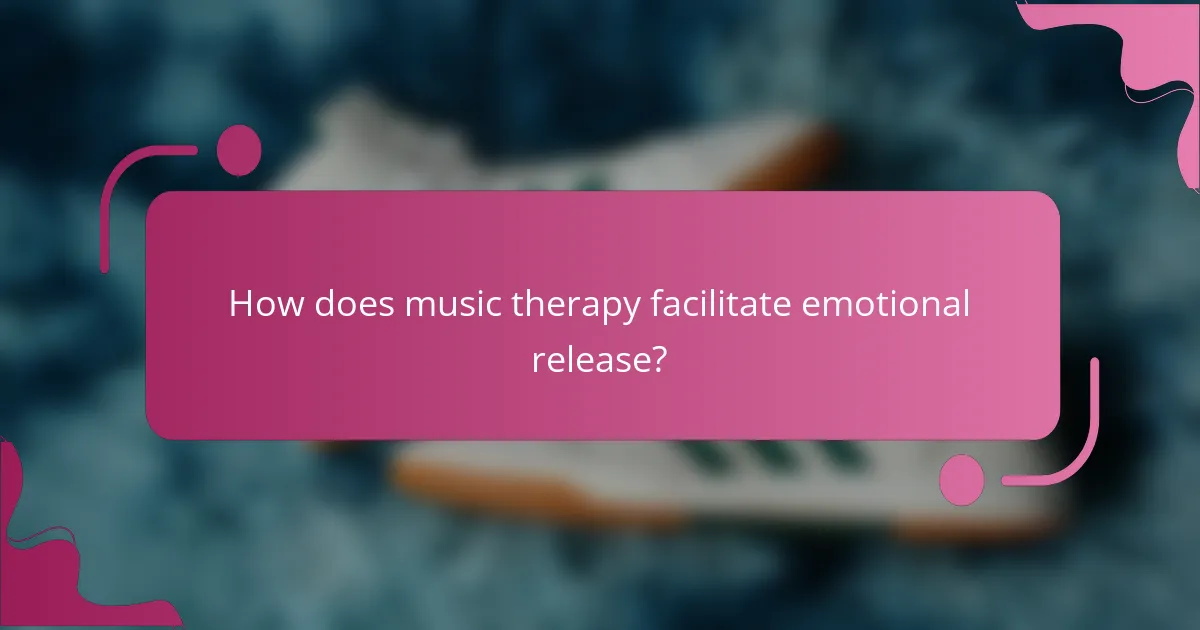
How does music therapy facilitate emotional release?
Music therapy facilitates emotional release by using sound to evoke feelings and memories. This approach helps individuals express emotions that may be difficult to articulate verbally. Techniques such as improvisation, songwriting, and guided listening create a safe space for emotional exploration. Studies show that music therapy can reduce anxiety and improve overall emotional well-being. In particular, it has been effective for individuals dealing with trauma, allowing them to process and release pent-up emotions in a constructive manner.
What techniques are used for emotional expression in music therapy?
Music therapy employs various techniques for emotional expression, including improvisation, songwriting, and guided imagery. These methods facilitate emotional release and cognitive improvement. For instance, improvisation allows individuals to express feelings spontaneously, while songwriting encourages reflection and personal storytelling. Guided imagery uses music to evoke mental images, enhancing relaxation and emotional processing. These approaches collectively support emotional well-being and therapeutic goals.
Which musical elements contribute to emotional release?
Music elements such as melody, rhythm, harmony, and dynamics significantly contribute to emotional release. Melody evokes feelings through its shape and progression. Rhythm influences mood and energy levels, while harmony adds depth and complexity to emotional expression. Dynamics create contrast, enhancing emotional impact during music therapy sessions.
How do cultural differences influence emotional responses to music in therapy?
Cultural differences significantly shape emotional responses to music in therapy by influencing perception and interpretation. Various cultures associate distinct emotions with specific musical elements, affecting therapeutic outcomes. For instance, Western cultures may prioritize harmony and structure, while Eastern cultures might emphasize rhythm and improvisation. These cultural frameworks guide therapists in selecting music that resonates with clients’ backgrounds, enhancing emotional release and cognitive improvement. Understanding these nuances fosters a more personalized therapeutic experience, leading to better relaxation and emotional healing.
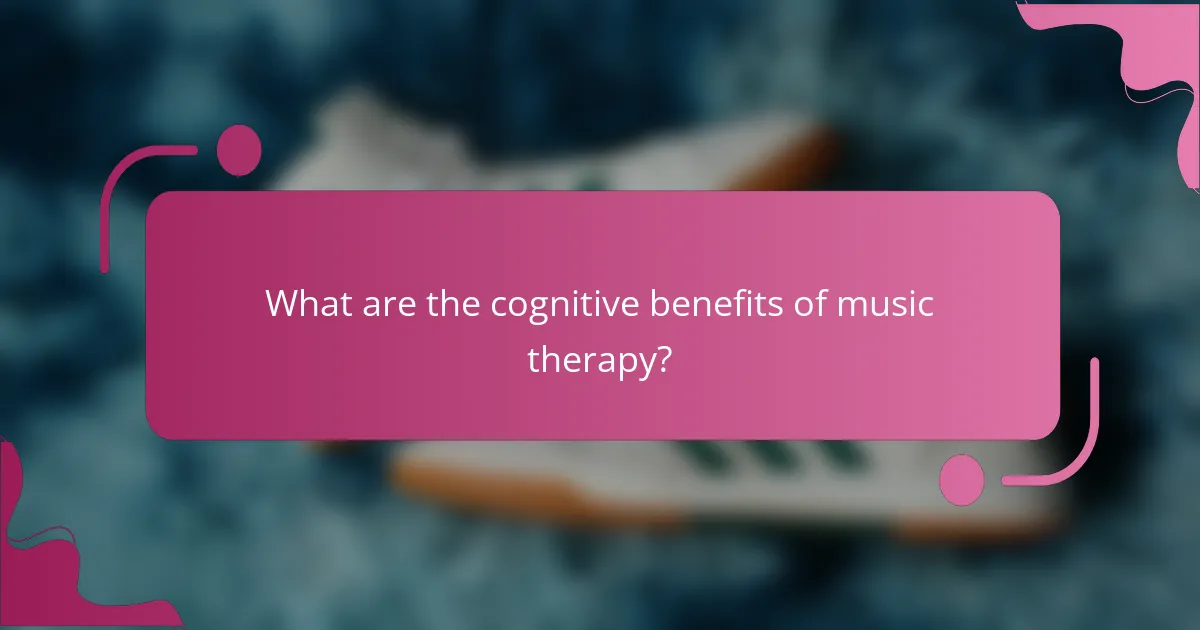
What are the cognitive benefits of music therapy?
Music therapy enhances cognitive functions such as memory, attention, and problem-solving skills. Engaging with music stimulates brain regions involved in these processes. Studies indicate that music therapy can improve cognitive performance in individuals with neurological disorders. For example, it has shown effectiveness in enhancing verbal memory and executive function among patients with dementia. Additionally, music therapy can aid in reducing anxiety, leading to improved focus and cognitive clarity.
How does music therapy enhance memory and learning?
Music therapy enhances memory and learning by engaging cognitive processes through musical activities. It stimulates brain areas associated with memory, improving recall and retention. Techniques such as singing, playing instruments, and rhythmic exercises promote neural connections, leading to better cognitive function. Furthermore, music therapy reduces anxiety, creating a conducive environment for learning. Research indicates that participants in music therapy exhibit improved memory performance compared to non-participants. This approach uniquely integrates emotional release and cognitive improvement, making it effective for diverse populations, including those with memory impairments.
Which cognitive functions can be improved through music therapy?
Music therapy can enhance various cognitive functions such as memory, attention, and problem-solving skills. Research indicates that engaging with music stimulates brain areas associated with these functions, promoting neural connections. For instance, music therapy has shown effectiveness in improving verbal memory in individuals with cognitive impairments. Additionally, rhythm and melody can enhance focus and concentration, making it a valuable tool for cognitive improvement.
What role does improvisation play in cognitive development during therapy?
Improvisation enhances cognitive development in therapy by fostering creativity and problem-solving skills. It encourages individuals to express emotions and explore new ideas, leading to improved mental flexibility. Engaging in musical improvisation can stimulate neural pathways, facilitating cognitive growth and emotional regulation. This process helps individuals develop better communication skills and enhances their ability to adapt to various situations.
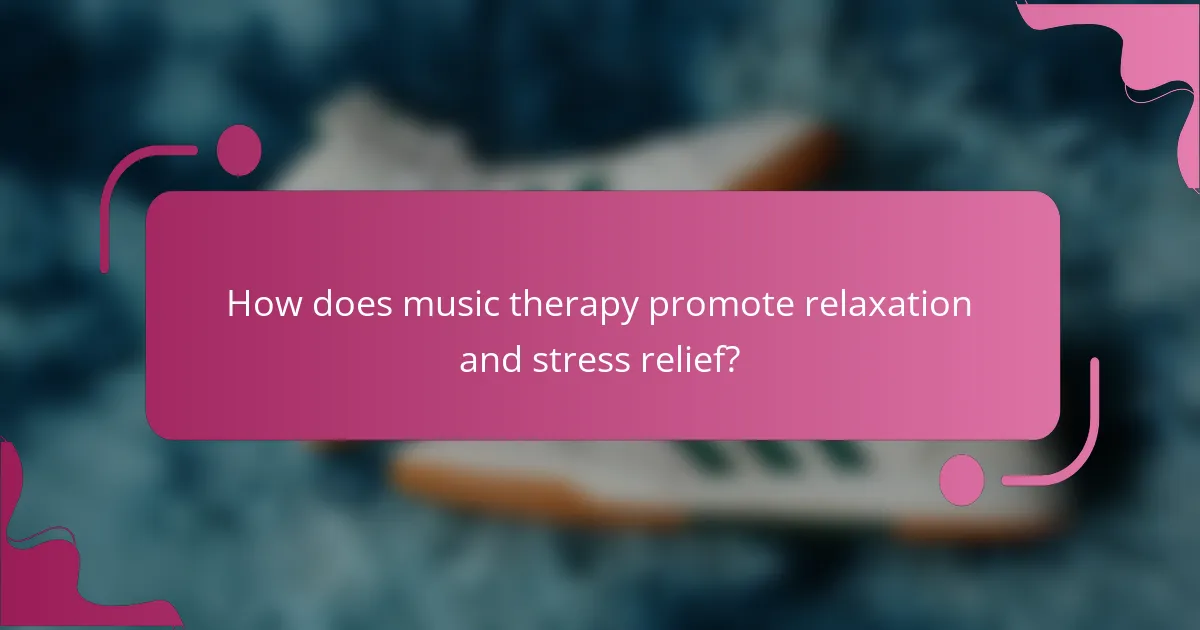
How does music therapy promote relaxation and stress relief?
Music therapy effectively promotes relaxation and stress relief through various approaches. Techniques such as guided imagery, live music, and rhythmic drumming engage the mind and body, facilitating emotional release. Research indicates that music therapy can lower cortisol levels, which are linked to stress. Additionally, it enhances cognitive functions by improving focus and reducing anxiety. Unique attributes of music therapy include personalized sessions tailored to individual needs, making it a versatile tool for emotional and mental well-being.
What specific methods are effective for inducing relaxation through music?
Music therapy methods effective for inducing relaxation include guided imagery, rhythmic entrainment, and active music-making. These approaches leverage sound to lower stress and enhance emotional well-being.
Guided imagery involves listening to music while visualizing peaceful scenes, promoting mental relaxation. Rhythmic entrainment uses consistent beats to synchronize body rhythms, aiding in stress reduction. Active music-making encourages expression and engagement, fostering emotional release.
Research shows that music therapy can significantly lower cortisol levels, enhancing relaxation. Each method offers unique benefits, making them versatile tools for emotional and cognitive improvement.
Which genres of music are most beneficial for relaxation in therapy?
Genres of music most beneficial for relaxation in therapy include classical, ambient, jazz, and nature sounds. These genres promote emotional release and cognitive improvement through calming rhythms and soothing melodies. Classical music, particularly compositions with slower tempos, has been shown to reduce anxiety levels significantly. Ambient music creates a tranquil atmosphere, enhancing mindfulness during therapy sessions. Jazz offers improvisational elements that can facilitate emotional expression. Nature sounds, such as rainfall or ocean waves, provide a grounding experience that fosters relaxation.
How do individual preferences affect relaxation outcomes in music therapy?
Individual preferences significantly influence relaxation outcomes in music therapy. Personal taste in music, familiarity with certain genres, and emotional associations with specific songs can enhance the therapeutic experience. When individuals engage with music that resonates with them, they report higher levels of relaxation and emotional release.
Research indicates that preferences for tempo, harmony, and instrumentation can lead to varied responses in relaxation levels. For instance, slower tempos often promote a calming effect, while familiar melodies can evoke positive memories, further enhancing relaxation.
Moreover, the therapeutic setting and the therapist’s ability to tailor music selections to individual preferences play crucial roles. A personalized approach that considers these unique attributes can lead to more effective outcomes in emotional release and cognitive improvement.
In conclusion, recognizing and integrating individual preferences in music therapy is essential for maximizing relaxation benefits. This personalized method aligns with the root attribute of music therapy, which is its adaptability to individual needs.
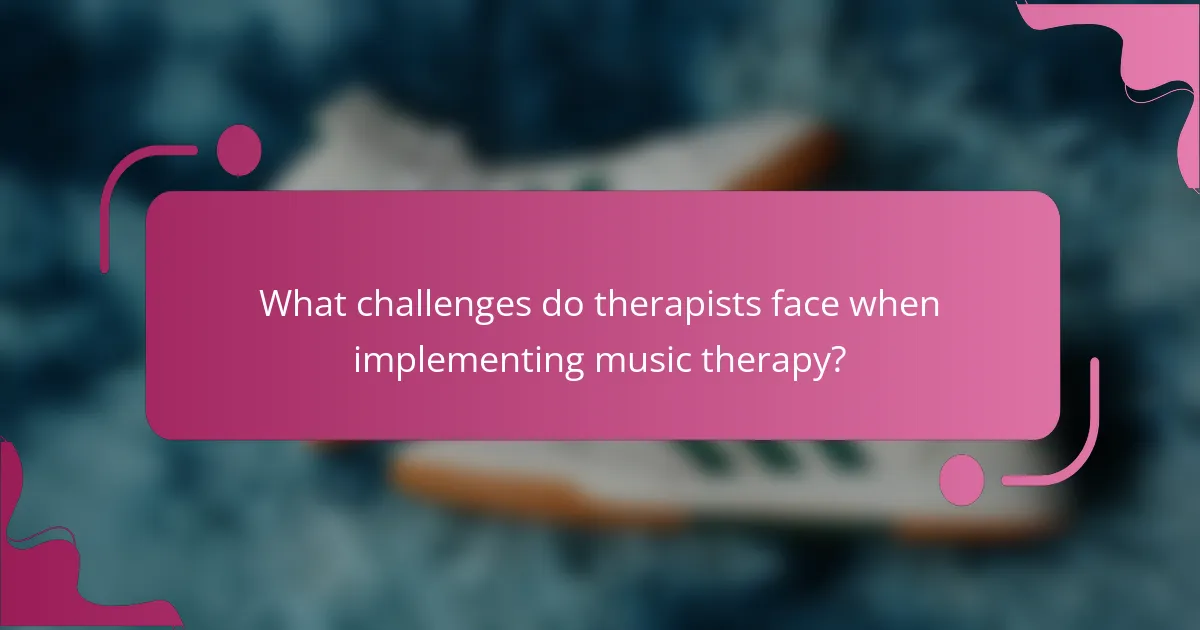
What challenges do therapists face when implementing music therapy?
Therapists face various challenges when implementing music therapy, including client resistance, limited training, and resource constraints. Client resistance may stem from unfamiliarity with the approach or skepticism about its effectiveness. Limited training can hinder therapists’ ability to integrate music therapy techniques effectively into their practice. Resource constraints, such as access to instruments and suitable spaces, can also impede the implementation of music therapy. Addressing these challenges is crucial for maximizing the benefits of music therapy in emotional release, cognitive improvement, and relaxation.
How can therapists overcome resistance from clients?
Therapists can overcome client resistance by using music therapy to foster emotional connection and engagement. Music therapy creates a safe space for clients to express feelings, facilitating openness. Techniques like improvisation and songwriting encourage clients to explore emotions creatively. Active listening and tailored interventions help build trust, making clients more receptive to therapeutic processes. Research shows that music therapy improves cognitive function and relaxation, further aiding in overcoming resistance.
What are the limitations of music therapy in different populations?
Music therapy has limitations across different populations, impacting its effectiveness. These limitations include accessibility, cultural relevance, and individual differences in response. For instance, individuals with severe cognitive impairments may struggle to engage with music therapy, limiting its benefits. Additionally, cultural interpretations of music can affect acceptance and efficacy, leading to varied outcomes. Lastly, personal preferences and psychological conditions can influence how individuals respond to music therapy, resulting in inconsistent results across diverse groups.
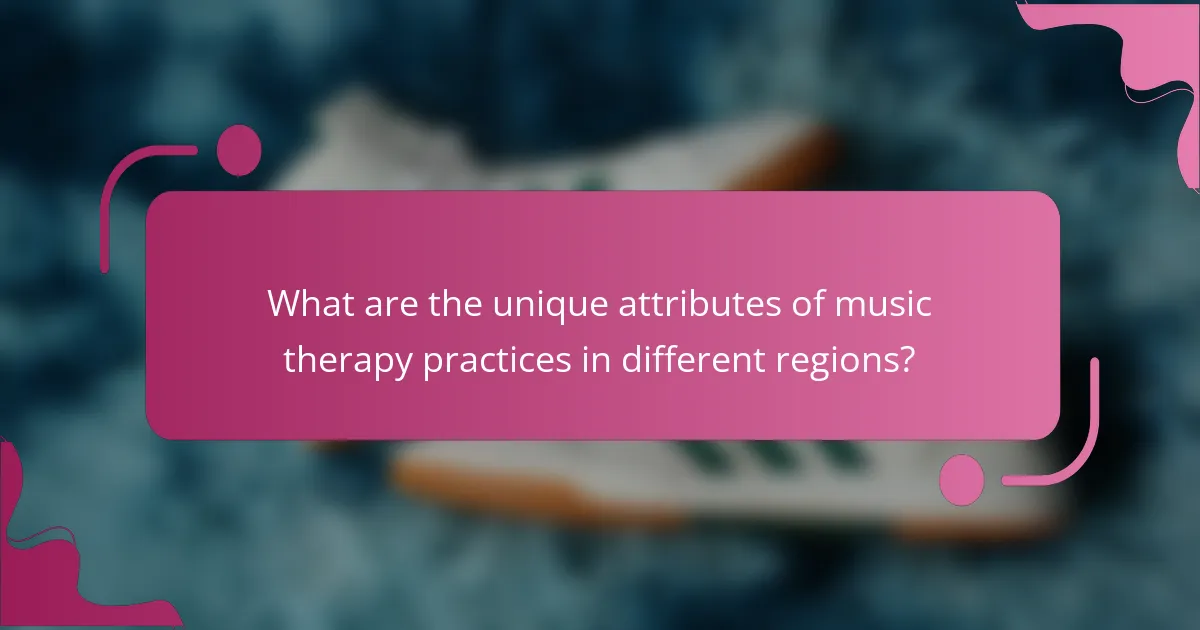
What are the unique attributes of music therapy practices in different regions?
Music therapy practices vary significantly across regions, each showcasing unique attributes influenced by cultural, social, and therapeutic contexts. In North America, evidence-based approaches prioritize cognitive improvement through structured sessions. In contrast, European practices often emphasize emotional release, integrating diverse musical genres. Asian therapies frequently focus on relaxation, utilizing traditional instruments and techniques for holistic well-being. Indigenous practices may incorporate storytelling and community engagement, highlighting the importance of cultural identity in healing. These regional differences illustrate the adaptability of music therapy to meet specific emotional and cognitive needs.
How do regional music styles influence therapy outcomes?
Regional music styles significantly enhance therapy outcomes by resonating with cultural identities and emotional experiences. Different styles, such as folk, classical, or contemporary, evoke unique emotional responses that can facilitate emotional release, cognitive improvement, and relaxation. For instance, folk music often incorporates community narratives, fostering a sense of belonging during therapy sessions.
Cognitive benefits arise as familiar melodies stimulate memory recall and cognitive engagement. Research indicates that music tailored to a client’s cultural background can improve focus and retention during therapy. Furthermore, relaxation is achieved as specific rhythms and harmonies in regional music can lower stress levels and promote a calming atmosphere.
Overall, integrating regional music styles into therapy not only respects individual cultural identities but also optimizes emotional and cognitive therapeutic outcomes.
Which local music therapy organizations are leading innovations?
Local music therapy organizations leading innovations include the Nordoff-Robbins Center, the American Music Therapy Association, and the Music Therapy Trust. These organizations focus on diverse approaches for emotional release, cognitive improvement, and relaxation, utilizing techniques like improvisation and songwriting. Their unique programs integrate technology and community engagement to enhance therapeutic outcomes. As a result, they significantly impact mental health and well-being through accessible music therapy services.
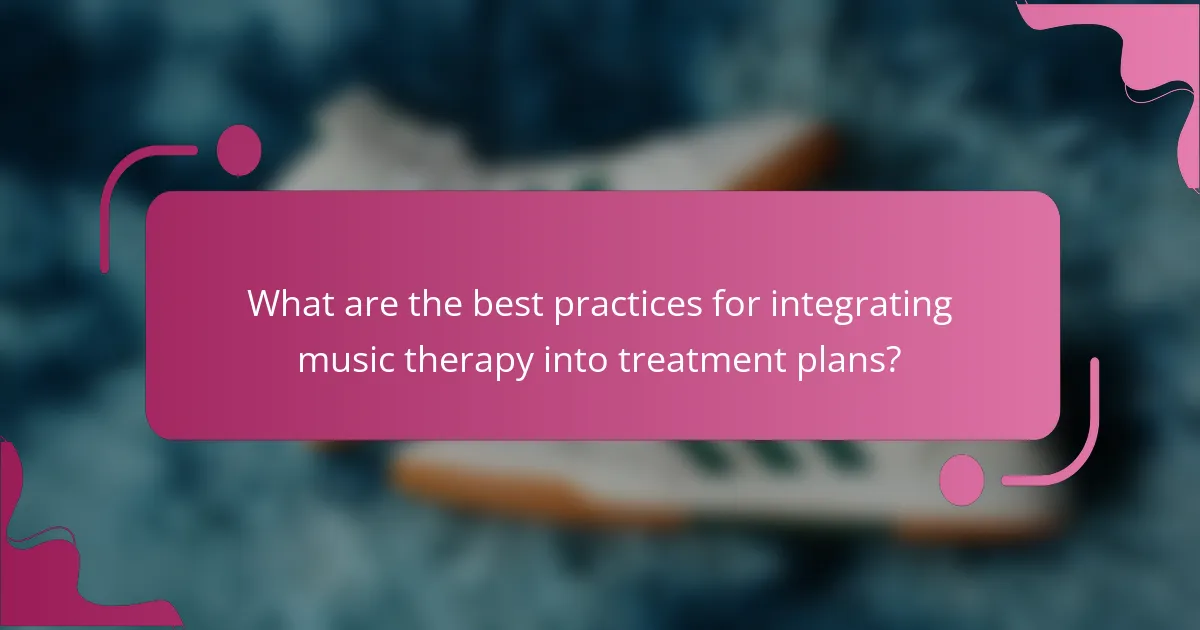
What are the best practices for integrating music therapy into treatment plans?
Integrating music therapy into treatment plans requires a structured approach. Prioritize personalized assessments to tailor interventions based on individual needs. Utilize diverse music styles to enhance emotional release, cognitive improvement, and relaxation. Regularly evaluate progress through feedback and adapt strategies accordingly. Foster collaboration among healthcare professionals to ensure a holistic treatment environment.
How can music therapy be tailored to individual needs?
Music therapy can be tailored to individual needs by assessing personal goals, preferences, and emotional states. Customized approaches include using specific genres or instruments that resonate with clients, creating playlists that evoke memories, and integrating therapeutic techniques like improvisation or songwriting. These methods enhance emotional release, cognitive improvement, and relaxation by aligning with the unique attributes of each individual. Regular feedback ensures ongoing adjustments, optimizing the therapeutic experience.
What common mistakes should be avoided in music therapy sessions?
To ensure effective music therapy sessions, avoid common mistakes such as neglecting individualized approaches, overlooking client feedback, and failing to create a safe environment. These errors can hinder emotional release, cognitive improvement, and relaxation.
Another mistake is using inappropriate music selections that do not resonate with the client’s preferences or therapeutic goals. This can diminish engagement and limit the effectiveness of the session.
Additionally, therapists should avoid rushing through activities without allowing adequate time for reflection and processing. This can prevent clients from fully experiencing the therapeutic benefits of the music.
Lastly, not setting clear objectives for each session can lead to unfocused and unproductive experiences. Establishing specific goals helps guide the therapy process and measure progress effectively.
What expert tips can enhance the effectiveness of music therapy?
Incorporating expert tips can significantly enhance music therapy’s effectiveness. Prioritize personalized sessions to address individual emotional needs. Utilize diverse musical styles to engage clients and promote cognitive flexibility. Foster a safe environment where clients feel comfortable expressing emotions through music. Regularly assess progress to adapt techniques and ensure optimal results. Consider integrating mindfulness practices to deepen relaxation and emotional release.
